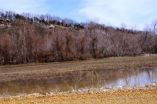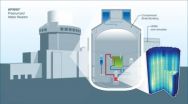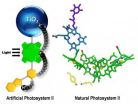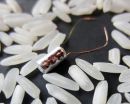(Press-News.org) URBANA, Ill. – The Cache River Basin, which once drained more than 614,100 acres across six southern Illinois counties, has changed substantively since the ancient Ohio River receded. The basin contains a slow-moving, meandering river; fertile soils and productive farmlands; deep sand and gravel deposits; sloughs and uplands; and one of the most unique and diverse natural habitats in Illinois and the nation.
According to a recent University of Illinois study, the region's agricultural lands dodged a bullet due to the timing of the great flood of April 2011 when the Ohio River approached the record high of 332.2 feet above sea level.
"The floodwaters eventually drained back into the Ohio River and upper Mississippi River ultimately leaving approximately 1,000 acres of agricultural land flooded from a backup in the middle and lower Cache River Valley, which flooded the adjacent forest-covered alluvial soils and the slightly higher cultivated soils," said U of I researcher Ken Olson.
According to Olson, who has studied the effects of that particular flood extensively, these cultivated soils drained by the middle of June 2011 and were planted to soybeans. The floodwaters left a thin silt and clay deposition on the agricultural lands and crop residue when they receded. These coatings included significant amounts of soil organic carbon, microbes, and pathogens. After the coatings dried, they were incorporated into the topsoil layer of the alluvial soils using tillage equipment.
"Because the flooding occurred during the non-growing season for corn and soybeans, the mixing in of sediment into the topsoil prior to planting resulted in little significant loss of soil productivity, little soybean damage, or yield reduction on lands outside the levees along the Mississippi, Cache, and Ohio rivers," Olson said.
As a result of the record Ohio River flood level, floodwaters passed north through the Post Creek cut-off, then west through the 2002 Karnak breach and into the middle Cache River valley to the Diversion to Mississippi River, which was already above flood stage so the floodwaters continued west. In late April, the Ohio River floodwaters then started to flood the towns of Olive Branch and Miller City, the Horseshoe Lake area, and surrounding agricultural lands. On May 2, 2011, the Len Small levee on the Mississippi River failed and resulted in the flooding of an additional 30,000 acres of Illinois public and private lands.
Illinois agricultural statistics recorded the harvest of 4,500 fewer acres of corn and 6,500 fewer acres of soybeans in Alexander County in 2011. Soybean production was 1,200,000 bushels in 2010 but dropped to 865,000 bushels in 2011 due to flooding from both the Ohio and Mississippi rivers and crop and soil damage. The floodwaters also scoured lands in some places and deposited sand in other locations.
Olson cautioned that, had winter wheat been planted outside the levees in the fall of 2010, the wheat crop would have drowned. "Illinois farmers are aware of the flooding potential, especially in the winter and early spring, so they don't plant winter wheat on unprotected bottomlands," he said. "Consequently, there was no crop loss outside the levees in April and May of 2011. Local floodwater in the lower Cache River Valley, south of the Mississippi River Diversion and Dike, could not flow back into the Ohio River. It was blocked by the Cache River levee on the south side and by the closed gate at the Ohio River levee. Instead, water backed up and flooded forested and agricultural lands along the lower Cache River and north of the Cache River levee," Olson said.
Olson said that the damage to the land could have been much worse. "Land use changes, diversion ditches and levees, loss of wetlands and flood-holding capacity, internal channelization of the Cache River and tributaries, and an ever-changing climate have altered the hydrology of the valley, redistributed soil from fields and ditch banks into the river, and transported tons of sediment during flooding events into both the Ohio and Mississippi rivers," Olson said.
As the 2011 Ohio River floodwater reclaimed its ancient floodway, Olson says that the extent of these hydrologic changes and their social, economic, and environmental impacts have become more apparent. "The Great Flood of 2011 lends urgency to the reevaluation and implementation of the Cache River Watershed Resource Plan completed in 1995," Olson said.
He cited nine resource concerns that were identified: erosion, open dumping, private property rights, water quality, continuation of government farm conservation programs, Post Creek Cutoff stream bank erosion, open flow on the Cache River, dissemination of accurate and timely information throughout the watershed, and the impacts of wildlife on farming and vice versa.
"Most of these concerns still need to be addressed," Olson said. "Since that plan was created, there have been additional compromises/breaches that need to be repaired. As the repair and rebuilding of the valley infrastructure is undertaken, there will need to be a significant investment of human and financial resources to reduce the impacts of future catastrophic events."
INFORMATION:
"The 2011 Ohio River flooding of the Cache River Valley in southern Illinois," which was co-authored by Kenneth R. Olson and Lois Wright Morton, was published in a 2014 issue of the Journal of Soil and Water Conservation and can be found online at http://www.jswconline.org/content/69/1/5A.full.pdf+html.
"Impacts of 2011 Len Small levee breach on private and public Illinois lands," co-authored by Kenneth R. Olson and Lois Wright Morton, was published in a 2013 issue of the Journal of Soil and Water Conservation and can be accessed online at http://www.jswconline.org/content/68/4/89A.full.pdf+html.
Partial funding for this research was provided by the Iowa Agriculture and Home Economics Experiment Station, College of Agriculture and Life Sciences at Iowa State University. Additional funding support came from National Great Rivers Research and Education Center, Regional Research, Project No. 15-372 and in cooperation with North-Central Regional Project No. NCERA-3 Soil Survey; and published with funding support from the Director of the Illinois Office of Research, ACES, University of Illinois.
Agricultural productivity loss as a result of soil and crop damage from flooding
2014-02-18
ELSE PRESS RELEASES FROM THIS DATE:
GW spirituality and health pioneer publishes paper on development of the field
2014-02-18
WASHINGTON (Feb. 18, 2014) — While spirituality played a significant role in health care for centuries, technological advances in the 20th century overshadowed this more human side of medicine. Christina Puchalski, M.D.'94, RESD'97, founder and director of the George Washington University (GW) Institute for Spirituality and Health and professor of medicine at the GW School of Medicine and Health Sciences (SMHS), and co-authors published a commentary in Academic Medicine on the history of spirituality and health, the movement to reclaim medicine's spiritual roots, and the ...
Neuropsychological assessment more efficient than MRI for tracking disease progression
2014-02-18
Amsterdam, NL, February 18, 2014 – Investigators at the University of Amsterdam, The Netherlands, have shown that progression of disease in memory clinic patients can be tracked efficiently with 45 minutes of neuropsychological testing. MRI measures of brain atrophy were shown to be less reliable to pick up changes in the same patients.
This finding has important implications for the design of clinical trials of new anti-Alzheimer drugs. If neuropsychological assessment is used as the outcome measure or "gold standard," fewer patients would be needed to conduct such ...
Artificial cells and salad dressing
2014-02-18
RIVERSIDE, Calif. (http://www.ucr.edu) — A University of California, Riverside assistant professor of engineering is among a group of researchers that have made important discoveries regarding the behavior of a synthetic molecular oscillator, which could serve as a timekeeping device to control artificial cells.
Elisa Franco, an assistant professor of mechanical engineering at UC Riverside's Bourns College of Engineering, and the other researchers developed methods to screen thousands of copies of this oscillator using small droplets. They found, surprisingly, that the ...
CASL, Westinghouse simulate neutron behavior in AP1000 reactor core
2014-02-18
OAK RIDGE, Tenn., Feb. 18, 2014 — Scientists and engineers developing more accurate approaches to analyzing nuclear power reactors have successfully tested a new suite of computer codes that closely model "neutronics" — the behavior of neutrons in a reactor core.
Technical staff at Westinghouse Electric Company, LLC, supported by the research team at the Consortium for Advanced Simulation of Light Water Reactors (CASL), used the Virtual Environment for Reactor Applications core simulator (VERA-CS) to analyze its AP1000 advanced pressurized water reactor (PWR). The testing ...
SDSC/UC San Diego researchers hone in on Alzheimer's disease
2014-02-18
Researchers studying peptides using the Gordon supercomputer at the San Diego Supercomputer Center (SDSC) at the University of California, San Diego (UCSD) have found new ways to elucidate the creation of the toxic oligomers associated with Alzheimer's disease.
Igor Tsigelny, a research scientist with SDSC, the UCSD Moores Cancer Center, and the Department of Neurosciences, focused on the small peptide called amyloid-beta, which pairs up with itself to form dimers and oligomers.
The scientists surveyed all the possible ways to look at the dynamics of conformational ...
Artificial leaf jumps developmental hurdle
2014-02-18
In a recent early online edition of Nature Chemistry, ASU scientists, along with colleagues at Argonne National Laboratory, have reported advances toward perfecting a functional artificial leaf.
Designing an artificial leaf that uses solar energy to convert water cheaply and efficiently into hydrogen and oxygen is one of the goals of BISfuel – the Energy Frontier Research Center, funded by the Department of Energy, in the Department of Chemistry and Biochemistry at Arizona State University.
Hydrogen is an important fuel in itself and serves as an indispensible ...
Wistar scientists develop gene test to accurately classify brain tumors
2014-02-18
cientists at The Wistar Institute have developed a mathematical method for classifying forms of glioblastoma, an aggressive and deadly type of brain cancer, through variations in the way these tumor cells "read" genes. Their system was capable of predicting the subclasses of glioblastoma tumors with 92 percent accuracy. With further testing, this system could enable physicians to accurately predict which forms of therapy would benefit their patients the most.
Their research was performed in collaboration with Donald M. O'Rourke, M.D., a neurosurgeon at the University ...
COXEN model picks the best drug for ovarian cancer
2014-02-18
There are three common drugs for advanced ovarian cancer: paclitaxel, cyclophosphamide, and topotecan. Like a shell game, if you pick the right drug a patient is likely to respond. And, unfortunately, picking the wrong drug can lead to treatment failure. As reported in this month's issue of the journal PLoS ONE, a University of Colorado Cancer Center and University of Virginia study used a sophisticated model of ovarian cancer genetics to match the right tumor with the right drug. Patients who were matched in this way lived an average 21 months longer than patients who ...
A battery small enough to be injected, energetic enough to track salmon
2014-02-18
RICHLAND, Wash. – Scientists have created a microbattery that packs twice the energy compared to current microbatteries used to monitor the movements of salmon through rivers in the Pacific Northwest and around the world.
The battery, a cylinder just slightly larger than a long grain of rice, is certainly not the world's smallest battery, as engineers have created batteries far tinier than the width of a human hair. But those smaller batteries don't hold enough energy to power acoustic fish tags. The new battery is small enough to be injected into an organism and holds ...
Controlling magnetism with an electric field
2014-02-18
Coral Gables, Fla. (Feb. 17, 2014) -- There is a big effort in industry to produce electrical devices with more and faster memory and logic. Magnetic memory elements, such as in a hard drive, and in the future in what is called MRAM (magnetic random access memory), use electrical currents to encode information. However, the heat which is generated is a significant problem, since it limits the density of devices and hence the performance of computer chips.
Scientists are now proposing a novel approach to achieve greater memory density while producing less heat: by using ...




